Not every gardener is blessed with a large garden and some just don’t want to tend a big space. Regardless of your garden’s size, you can still grow an abundance of fresh veggies each year with container gardening.
Containers are a perfect solution for gardening in a small space, an underutilized space, or to expand your garden footprint. Almost any vegetable or small fruit can be grown in a container, and there are loads of vegetable varieties that have been specifically developed for that purpose.
Growing in containers also allows you to be more flexible. For example, if your garden’s location doesn’t receive the 6 to 8 hours of sunlight required for most vegetable plants, you can place containers where they’ll be sure to get that adequate sunlight.
And let’s talk about weeding. It’s a constant chore in any garden plot or raised bed. But with containers, weeding is practically null. What more could you ask for?
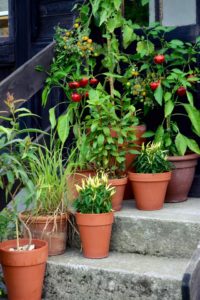 Containers are also a great way to bring pollinators, hummingbirds, and butterflies into your garden. Placing a few pots of nectar-rich flowers around your vegetable bed or among other containers is a sure way to help pollinate vegetables and they look great too!
Containers are also a great way to bring pollinators, hummingbirds, and butterflies into your garden. Placing a few pots of nectar-rich flowers around your vegetable bed or among other containers is a sure way to help pollinate vegetables and they look great too!
Choosing Plant Varieties
As mentioned, just about any vegetable or small fruit can be grown in a container, but for the best success, look for varieties that have been developed specifically for small-space or container growing.
Look for terms such as “dwarf” or “bush” on seed packets and plant tags. Or choose varieties with a smaller footprint, like determinate or patio tomatoes and bush varieties of vining vegetables like cucumbers and squash. These smaller growing varieties are very well suited for containers.
One thing to keep in mind: “small” fruit size does not always equate to “small” plant size. Currant tomatoes have tiny fruit, but the plants can grow to 7 feet tall. The same is true with mini pumpkins; vines can grow to 10 feet long. Many small-plant varieties produce full-size fruit, but not all small size fruit grow on small size plants.
Here are a few vegetables to consider:
- Any determinate, dwarf, or patio variety of tomato
- All varieties of peppers and eggplant
- Bush varieties of cucumber, squash, peas, and beans
- All varieties of salad greens, lettuces, spinach, chard, kale, and mustards
- Root and bulb vegetables like radishes, beets, carrots, turnips, and onions
- Small fruits such as strawberries, ground cherries, and dwarf varieties of raspberries
- Any herb such as basil, cilantro, parsley, thyme, chives, oregano, and sage
Choosing a Container
One of the key elements to successful container gardening is choosing a container that is the correct size for the plant. Since the plant’s roots will be contained within the vessel, you’ll want to make sure the there is enough room for proper root development.
Most vegetables need a minimum container depth of 8 inches – although onions can get by with a shallow 6 inches. Other veggies, like tomatoes and carrots require a container that is at least 12 inches deep, preferably more, for optimum root development and plant growth.
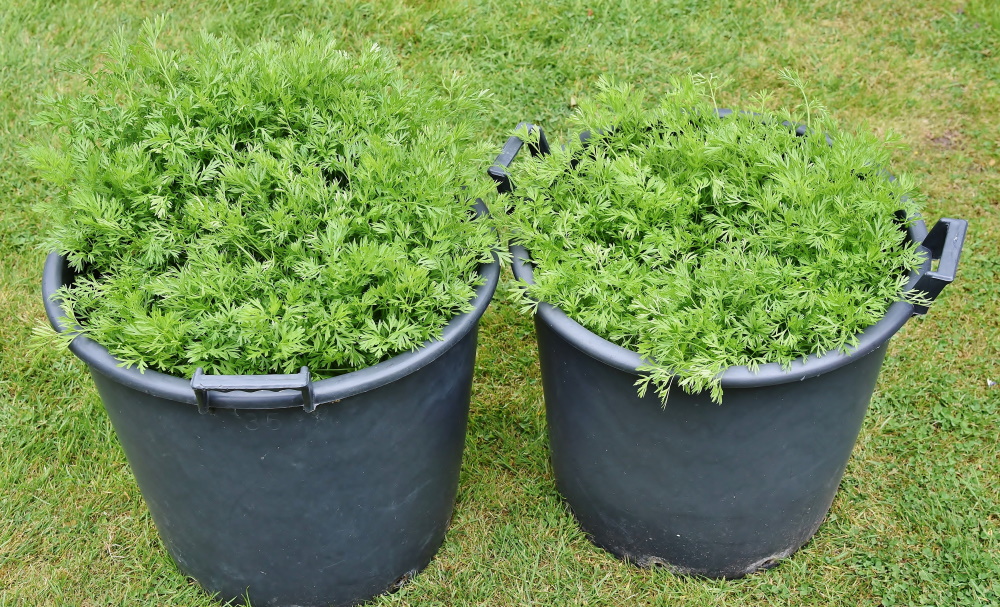
Carrots can be grown in containers too — just make sure the vessel is at least 12 inches deep. These garden buckets work great!
Container Sizes for Common Vegetable Plants
|
Vegetable |
Minimum Container Depth |
Recommended Size/Plant |
|
Tomato |
12 inches |
2 to 5 gallon per plant |
|
Pepper |
8 inches |
2 to 5 gallon per plant |
|
Eggplant |
8 inches |
4 to 5 gallon per plant |
|
Squash |
8 inches |
5 gallon per plant |
|
Cucumber |
8 inches |
3+ gallon per plant, trellis |
|
Beans |
8 inches |
|
|
Peas |
8 inches |
trellis |
|
Radish, Turnip, Beet |
8 inches |
|
|
Onion |
6 inches |
|
|
Carrot |
12 inches |
|
|
Lettuces/Greens |
8 inches |
|
Chart adapted from Colorado State University Extension Master Gardeners
When it comes to selecting a container, you can choose just about anything as long as it has good drainage holes and is free of harmful chemicals that could leach into the soil (for example, treated or painted wood, etc.).
Local plant nurseries and garden stores stock a variety of containers made from clay, plastic, and resin in all sorts of sizes, shapes, and colors.
Here are a few of my observations about container types:
- Containers made from clay tend to be heavier, dry out more frequently, and need to be stored in a dry location over the winter months to keep them from cracking (at least in our northern climate).
- Plastic and resin containers are lightweight and easier to store, but be aware that dark–colored plastic containers will absorb more heat in direct sunlight and could potentially damage roots that grow near the container’s sides.
- Inexpensive, large plastic storage tubs or half-barrels (plastic or wooden) are perfect for plants that need a little more room to grow, such as larger tomato varieties and squash.
- For functionality, consider grow bags. These large, durable fabric pouches come in various sizes from 1 quart to 5 gallons or more. They are breathable, reusable, and are easy to store at the end of the season. They may not have the look of an antique urn, but they are super-functional for growing lots of tomatoes and peppers.
You can also get creative and reuse or upcycle discarded items, such as watering troughs, crates, wheelbarrows, and the like. Just make certain the size is right for the plant and it has good drainage holes. Keep in mind, the larger the container, the more water and nutrients it can hold. And that leads us to how to care for your container garden.
Caring for Your Container Garden
A container garden needs a little more attention than a regular plot or raised bed garden. Containers have a tendency to dry out quicker (even large containers) and plants will need frequent watering and fertilizing to produce a good harvest.
It’s critical to use a quality potting soil in your containers. This is not the place to use inferior potting soil or soil from your yard (which is too dense and may contain weed seeds, harmful insects, or fungal diseases).
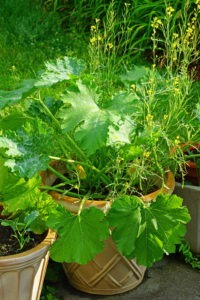
Vegetables are heavy feeders, especially squash and cucumbers and require weekly fertilizing when grown in containers.
Choose a potting mix that is well-drained, well-aerated and has a pH that is close to neutral (pH 7). Quality potting soil will consist of an organic mixture of peat moss or coir, compost, and vermiculite or perlite for aeration and moisture retention.
I don’t use potting mixes with added fertilizer (beyond compost), as I like to mix in an organic, slow-release granular fertilizer when planting. I also top-dress the plants with a good compost.
Vegetables grown in containers need to be fertilized about once a week (or per the fertilizer’s application instructions). The reason for this is that potting mix doesn’t contain a lot of nutrients to begin with and all that watering has a way of washing nutrients from the soil. Compounding the issue, vegetable plants are very heavy-feeders and need a steady stream of nutrients to be productive. An organic water-soluble fertilizer, like fish emulsion, is a good choice for weekly feedings. Please make sure to read and follow all directions on the fertilizer label.
Container gardening is easy to do and adds interest and beauty to your landscape. But just like any type of gardening, the overall success depends on having the right plant, in the right location, along with the right container size, good soil quality, and your dedication to watering and fertilizing. Here’s to turning your small space into a flourishing veggie patch!
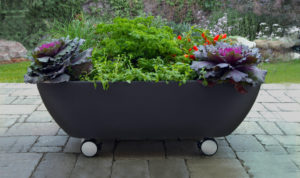
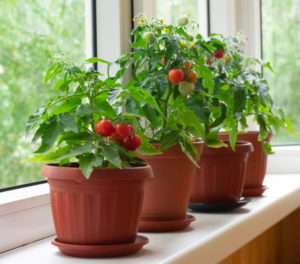
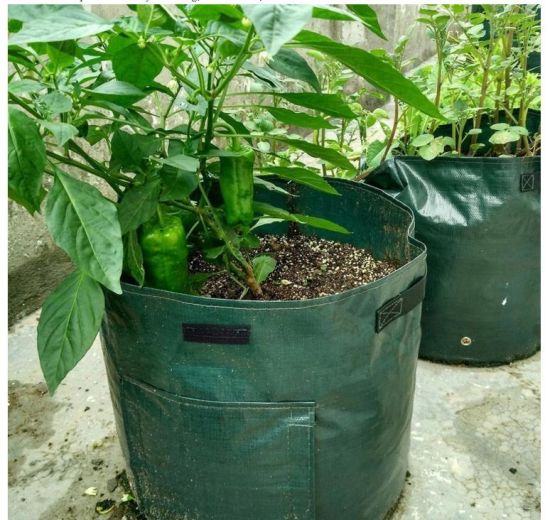


Leave a Reply